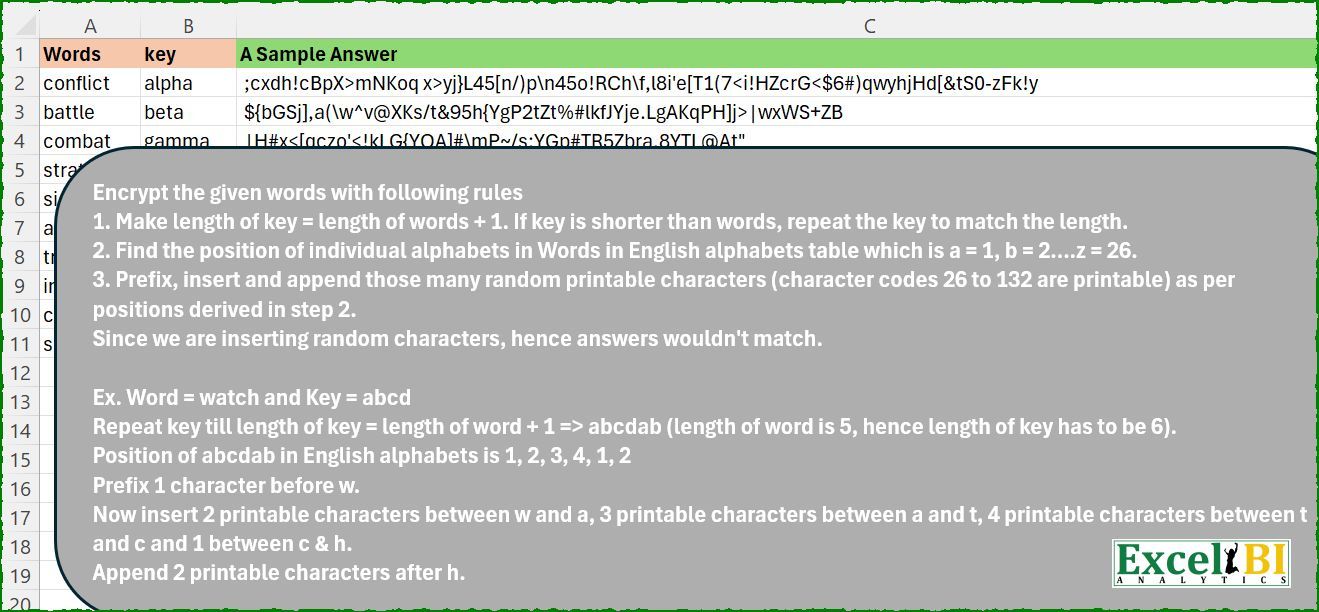library(tidyverse)
library(readxl)
path = "Excel/633 Encryption by Printable Characters.xlsx"
input = read_excel(path, range = "A1:B10")
n_random_chars <- function(n) {
random_chars = sample(32:132, n, replace = TRUE) %>%
intToUtf8()
return(random_chars)
}
encode_word = function(word, key) {
word = strsplit(word, "")[[1]]
key = strsplit(key, "")[[1]]
l_word = length(word)
l_key = length(key)
key = if (l_word > l_key) rep(key, length.out = l_word + 1) else key[1:(l_word + 1)]
df = data.frame(word = c(word, ""), key = key) %>%
mutate(key_num = map_dbl(key, ~which(.x == letters)),
random_chars = map_chr(key_num, ~n_random_chars(.x))) %>%
unite("encoded", word, random_chars, sep = "", remove = F) %>%
summarise(encoded = paste(encoded, collapse = "")) %>%
pull(encoded)
return(df)
}
result = input %>%
mutate(Sample_answer = map2_chr(input$Words, input$key, ~encode_word(.x, .y)))Excel BI - Excel Challenge 633

Challenge Description
Encrypt the given words with following rules 1. Make length of key = length of words + 1. If key is shorter than words, repeat the key to match the length. 2. Find the position of individual alphabets in Words in English alphabets table which is a = 1, b = 2….z = 26. 3. Prefix, insert and append those many random printable characters (character codes 32 to 132 are printable) as per positions derived in step 2. Since we are inserting random characters, hence answers wouldn`t match.
Ex. Word = watch and Key = abcd Repeat key till length of key = length of word + 1 => abcdab (length of word is 5, hence length of key has to be 6). Position of abcdab in English alphabets is 1, 2, 3, 4, 1, 2 Prefix 1 character before w. Now insert 2 printable characters between w and a, 3 printable characters between a and t, 4 printable characters between t and c and 1 between c & h. Append 2 printable characters after h.
🔗 Link to Excel file: 👉https://lnkd.in/dTjyZk5r
Solutions
Logic:
strsplit: Splits words and keys into individual characters.Key length adjustment: Repeats or truncates the key to match
wordlength + 1.map_dblandmap_chr: Calculate character positions in the alphabet and generate random characters accordingly.unite: Combines the original word characters and random characters.
Strengths:
Compactness: Tidyverse functions streamline the workflow.
Flexibility: Handles key adjustments and random character generation dynamically.
Areas for Improvement:
Randomness Testing: Ensure randomness meets the specifications (ASCII 32–132).
Performance: Larger datasets may benefit from optimized vectorized operations.
Gem:
- The dynamic generation of random characters based on alphabet positions is both elegant and modular.
import pandas as pd
import random
import string
path = "633 Encryption by Printable Characters.xlsx"
input = pd.read_excel(path, usecols="A:B", nrows=10)
def n_random_chars(n):
random_chars = ''.join(random.choices(string.printable, k=n))
return random_chars
def encode_word(word, key):
key = (key * (len(word) // len(key) + 1))[:len(word)]
key_num = [string.ascii_lowercase.index(k) + 1 for k in key]
return ''.join([w + n_random_chars(num) for w, num in zip(word, key_num)])
input['Sample_answer'] = input.apply(lambda row: encode_word(row['Words'], row['key']), axis=1)
print(input)Logic:
Key adjustment: Repeats the key to match
wordlength.string.ascii_lowercase.index(k) + 1: Maps key characters to their alphabet positions.n_random_chars: Generates random printable characters for each word and key character pair.apply: Applies the encoding function row-wise.
Strengths:
Explicit Logic: The operations are broken down into clear steps.
Ease of Understanding: Direct string manipulation and Python’s standard library functions are used effectively.
Areas for Improvement:
- Randomness Consistency: Ensure random choices are constrained to ASCII 32–132 (not all of
string.printablefalls in this range).
- Randomness Consistency: Ensure random choices are constrained to ASCII 32–132 (not all of
Gem:
- The use of
zipto pair word characters and key numbers for processing is intuitive and compact.
- The use of
Difficulty Level
This task is moderate:
Requires string manipulation and dynamic key adjustment.
Involves understanding of character encoding and randomness.